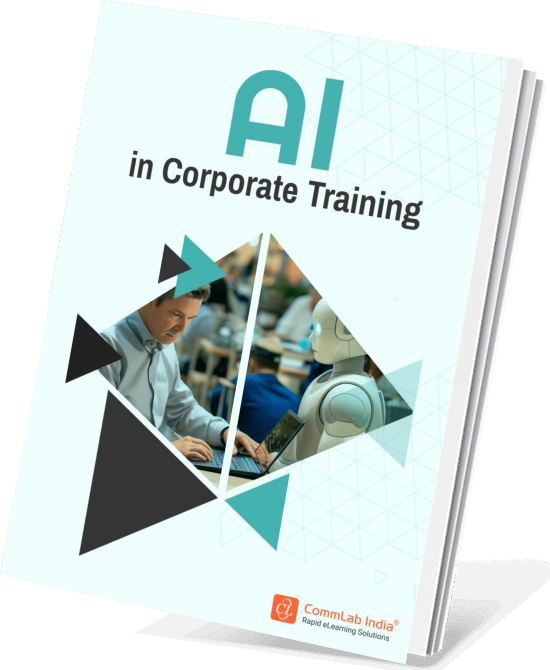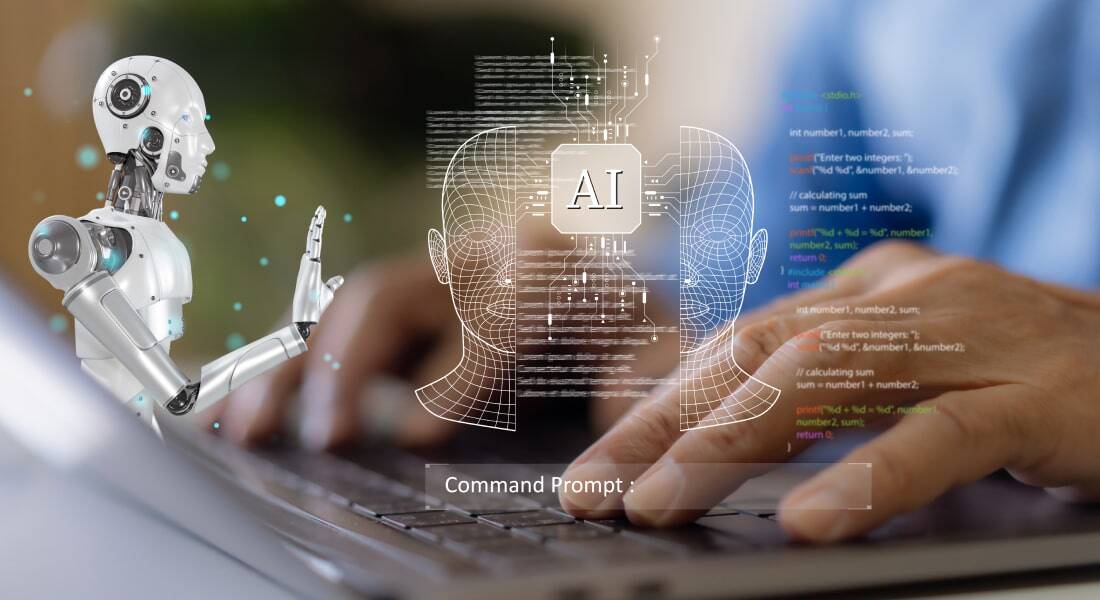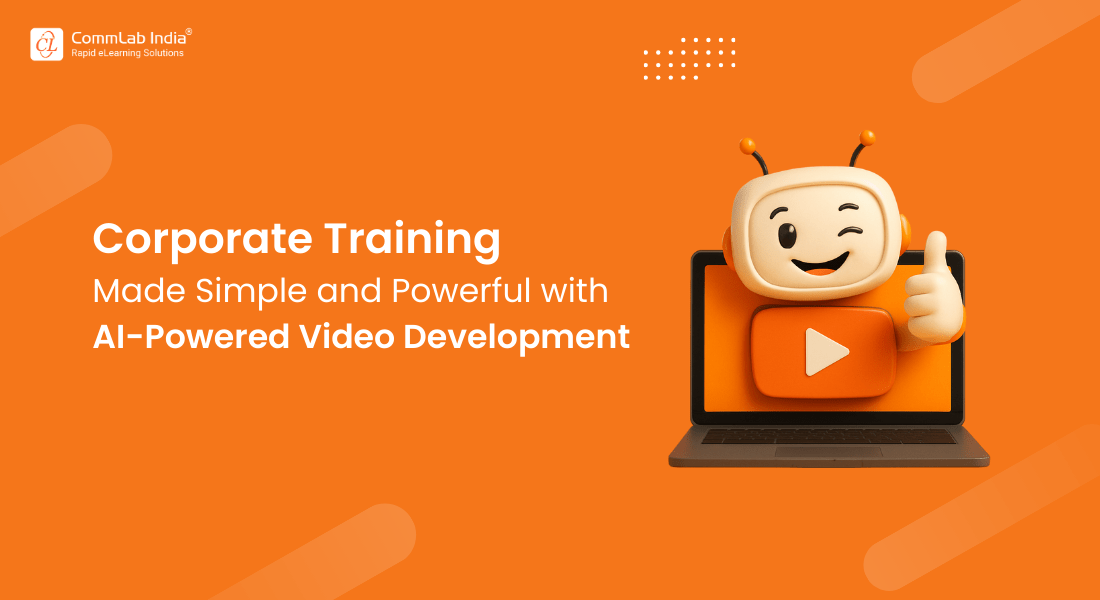11 Common Questions on AI for L&D Answered

As organizations continue to evolve, their learning and development (L&D) strategies must adapt to keep pace. One of the most powerful forces driving this change is Artificial Intelligence (AI). Once considered a futuristic concept, AI has become a practical tool that is reshaping how we deliver, measure, and personalize corporate learning programs. Despite its growing influence, many L&D professionals still seek clarity on how AI can be effectively integrated into their training strategies.
In this blog, we’ll discuss the 11 most common questions L&D professionals have about AI, offering practical answers and deep insights into how this technology is revolutionizing corporate learning. From personalized learning paths to AI-powered content creation and data-driven decision-making, we will explore the key benefits AI brings to L&D. By understanding these applications, professionals can make more informed choices about how to leverage AI to enhance their training programs and learner outcomes.
→ Download eBook: AI in Corporate Training, Partner, Not Replacement [FREE]
Table of Contents
- What Is AI in the Context of L&D?
- How Can AI Improve Personalized Learning in L&D?
- What AI Tools Are Commonly Used in L&D Today?
- How Does AI Impact Content Development and Curation for L&D?
- Can AI Enhance Learner Engagement and Motivation in L&D Programs?
- How Does AI Support Data-Driven Decision-Making in L&D?
- What Ethical Considerations Should L&D Professionals Have When Using AI?
- Can AI Replace Human Instructors in L&D?
- How Can AI Be Used to Measure Learning Effectiveness in L&D?
- How Do AI and Automation Benefit L&D Professionals?
- What Are the Future Trends of AI in L&D?
1. What Is AI in the Context of L&D?
Artificial Intelligence, or AI, refers to computer systems designed to mimic human intelligence. In the context of L&D, AI automates tasks, personalizes learning experiences, and helps improve the effectiveness of training programs. But it’s more than just a buzzword—it’s a tool that’s changing the very fabric of learning design and delivery.
Core AI technologies:
AI in L&D primarily uses machine learning, natural language processing (NLP), and data analytics.
- Machine learning: Algorithms that allow systems to learn from data and improve over time.
- NLP: Enables AI to understand and respond to human language.
- Data analytics: AI systems analyze vast amounts of data to provide actionable insights into learner behaviors and needs.
AI applications in L&D
- Personalized learning: Tailors content and experiences based on individual learner needs.
- Automation: Speeds up tasks such as grading, scheduling, and content recommendations.
- Chatbots: Provide real-time assistance and feedback to learners.
2. How Can AI Improve Personalized Learning in L&D?
One of the most significant advantages AI brings to Learning and Development (L&D) is its capacity to create highly personalized learning experiences. Every learner has unique needs, learning styles, and pacing. AI allows L&D teams to harness this individuality by designing adaptive learning paths that cater to each learner's strengths, weaknesses, and preferences. This results in more effective, engaging, and meaningful training.
Tailoring learning paths:
AI continually assesses learners' behaviors and progress, adjusting the learning process in real-time to fit their needs. For example:
- If a learner struggles with a particular concept, AI can suggest supplementary resources, such as videos or interactive learning exercises, to reinforce their understanding.
- Conversely, for learners who demonstrate a firm grasp of the material, AI can offer more challenging tasks or advanced modules, preventing boredom and maintaining engagement.
Real-time adjustments:
AI ensures that content is dynamically modified based on the learner's performance:
- Learners receive instant feedback after completing quizzes, allowing them to understand their mistakes and improve immediately.
- As learners move through the material, AI can adjust the difficulty of the tasks, providing a customized experience that grows with the learner's capabilities.
Enhancing learner engagement:
AI personalizes not only the content but also the learning journey itself:
- AI-driven systems can recommend specific interactive elements, quizzes, or challenges based on the learner's previous behavior, ensuring engagement remains high.
- It can even suggest the most productive times for learners to engage with content, based on their past patterns, optimizing focus and retention.
Through these tailored strategies, AI enables a more learner-centric approach to corporate training, fostering improved performance and greater satisfaction.

How AI-Driven Adaptive Learning Enhances Personalization and Inclusivity in L&D
AI-driven adaptive learning paths allow L&D professionals to create personalized learning experiences by tailoring content based on individual learner performance, preferences, and progress. With real-time adjustments and AI-powered insights, courses can dynamically evolve to meet each learner's needs, improving engagement and knowledge retention. Additionally, AI tools can enhance accessibility and inclusivity by offering features like captions, flexible navigation, and support for neurodiverse learners, ensuring that corporate training is effective for everyone.
3. What AI Tools Are Commonly Used in L&D Today?
AI tools are becoming increasingly integrated into L&D systems, from Learning Management Systems (LMS) to content development platforms. These AI-driven tools automate administrative tasks, personalize learning experiences, and provide analytics that help improve the effectiveness of training programs.
AI-powered LMS platforms:
Many modern LMS platforms now come with AI-enhanced features to deliver more personalized and efficient learning experiences:
- Docebo: This LMS uses AI to recommend tailored learning paths based on learner behavior, automate content curation, and provide real-time insights into learner performance.
- Lingio: Known for its AI-driven language learning modules, Lingio adapts content based on an individual's progress, ensuring personalized learning experiences that evolve with the learner’s needs.
Content development tools:
AI is also revolutionizing how training content is created and curated:
- AI-driven content creation: Platforms like Articulate 360 and Rise employ AI algorithms to streamline content development, offering recommendations for design improvements and optimizing the flow of learning materials. These authoring tools significantly reduce the time and effort required for course creation.
- Automated content curation: AI tools analyze learner preferences, past interactions, and performance to recommend the most relevant content—whether it be articles, videos, or interactive quizzes—ensuring that learners receive materials tailored to their specific learning needs and goals.
By integrating these AI tools into L&D systems, organizations can provide more personalized, efficient, and impactful learning experiences.

AI in Corporate Training
Partner, Not Replacement
- AI in Corporate Training
- AI Toolkit for Super-charged Learning
- Challenges to Consider with AI Implementation
- And More!
4. How Does AI Impact Content Development and Curation for L&D?
Creating high-quality, engaging content is one of the most time-consuming tasks in Learning and Development (L&D). AI offers the potential to significantly streamline this process, allowing instructional designers and content developers to produce more customized, relevant content at a faster pace, all while maintaining a high level of engagement and quality.
AI-assisted content development:
AI can assist in generating new content and improving existing material through data-driven insights. By analyzing learner behaviors and engagement data, AI can suggest content improvements and help optimize the overall learning experience. For example:
- AI tools can recommend changes to the structure or layout of a course, such as adjusting content flow to enhance learner engagement and comprehension.
- AI can automatically generate quizzes, assessments, or interactive activities based on the course content, reducing the workload for instructional designers and ensuring that evaluations are aligned with learning objectives.
AI for content curation:
AI's ability to curate content is one of its most valuable contributions to L&D. By sifting through large amounts of data, AI can identify the most relevant resources for each learner. This ensures that learners are always receiving personalized content that matches their needs and interests:
- AI can recommend various types of content, such as articles, videos, podcasts, or interactive modules, based on the learner’s previous activities and preferences.
- As new and more relevant content becomes available, AI can automatically update learning paths, ensuring learners are exposed to the most up-to-date materials.
Through these capabilities, AI greatly enhances both the efficiency and effectiveness of content development and curation in corporate training programs.
5. Can AI Enhance Learner Engagement and Motivation in L&D Programs?
Learner engagement is a significant challenge for L&D professionals, but AI can provide powerful solutions by creating more interactive, personalized, and motivating learning experiences. Through adaptive strategies and dynamic content, AI helps keep learners engaged and motivated throughout their training journey.
Gamification powered by AI:
AI facilitates the integration of gamification elements into learning paths, making the learning process more engaging and rewarding:
- Learners can earn badges, points, or rewards for completing tasks or reaching milestones, adding an element of fun and achievement to the experience.
- AI tracks learner progress and suggests motivational boosts like bonus points or recognition when learners hit specific goals, driving further engagement and satisfaction.
Interactive learning:
AI enhances the interactivity of online courses by creating dynamic learning environments:
- AI-driven tools provide immediate, personalized feedback during quizzes or simulations, helping learners understand their mistakes and improve in real time.
- Interactive, AI-powered scenarios can adjust based on the learner’s choices, creating a more engaging experience that evolves with their decisions, keeping the content fresh and exciting.
AI-driven feedback:
AI ensures that learners receive personalized, actionable feedback rather than generic responses:
- It analyzes quiz results and offers tailored advice for areas of improvement, ensuring learners understand what steps to take to progress.
- By recognizing patterns in learner behavior, AI can suggest adjustments, such as focusing on specific topics or revisiting previous content, to help learners stay motivated and on track.
Through these AI-driven features, L&D programs can foster deeper learner engagement, leading to better learning outcomes and increased learner motivation.
6. How Does AI Support Data-Driven Decision-Making in L&D?
The capability of AI to process extensive datasets instantly positions it as a crucial asset for making informed decisions in L&D. AI-powered analytics help L&D professionals optimize their training programs by providing insights into learner behavior, content effectiveness, and overall performance.
Data collection and analysis:
AI tools track and analyze learner data throughout the training process:
- Monitors quiz results, time spent on tasks, and engagement levels.
- Provides detailed insights into which content resonates with learners and which areas need improvement.
Predictive analytics:
AI doesn’t just look at current data; it also predicts future outcomes:
- Analyzes learner behavior to predict which individuals might struggle and provides early interventions.
- Forecasts overall training program success based on current trends, helping L&D teams make proactive decisions.
Continuous improvement:
With AI, data isn’t just a one-time resource. It continuously gathers feedback to improve learning paths:
- AI adjusts content based on performance, making the training program more effective over time.
- Insights from AI data can help refine course designs, leading to better learner outcomes.
7. What Ethical Considerations Should L&D Professionals Have When Using AI?
As powerful as AI is, it’s important to approach its implementation with caution, particularly when it comes to ethics. Ethical considerations are critical to ensuring that AI is used responsibly in learning environments.
Data privacy concerns:
AI systems often rely on large datasets, which raises questions about data privacy and security:
- Ensure that all AI tools comply with data protection regulations such as GDPR.
- Be transparent with learners about what data is being collected and how it’s being used.
Avoiding bias in AI algorithms:
AI systems are only as unbiased as the data they are trained on. If an AI model is trained on biased data, it can perpetuate those biases in learning recommendations:
- Regularly audit AI systems to ensure they are not producing biased results.
- Use diverse datasets to train AI models, ensuring inclusivity in learning paths and content recommendations.
Transparency and control:
L&D professionals should maintain transparency when using AI:
- Provide learners with control over their data and allow them to opt-out of certain AI-driven features.
- Be clear about how AI influences learning paths and content recommendations, so learners understand why they are receiving certain suggestions.

AI in Corporate Training
Partner, Not Replacement
- AI in Corporate Training
- AI Toolkit for Super-charged Learning
- Challenges to Consider with AI Implementation
- And More!
8. Can AI Replace Human Instructors in L&D?
While AI is a powerful tool, it is not a replacement for human instructors. Instead, AI serves as a complement to human expertise, allowing instructors to focus on higher-order tasks while AI handles repetitive, time-consuming ones.
The human-AI partnership:
AI can automate certain tasks, but human instructors bring empathy, creativity, and critical thinking to the learning process:
- AI can handle administrative tasks, such as grading and scheduling, allowing instructors to focus on learner interaction.
- Human instructors can offer personalized guidance, emotional support, and mentorship that AI cannot replicate.
AI as an enabler, not a replacement:
Rather than viewing AI as a replacement, think of it as an enabler:
- AI helps instructors provide more personalized attention by offering real-time data on learner progress.
- It automates repetitive tasks, freeing up time for instructors to focus on creating meaningful learning experiences.
9. How Can AI Be Used to Measure Learning Effectiveness in L&D?
Measuring the effectiveness of a training program is one of the most challenging tasks for L&D professionals. AI offers powerful tools to help assess learning outcomes, providing data-driven insights into learner performance and overall program success.
Tracking learner progress:
AI tracks individual learner progress in real time, offering insights into:
- Completion rates, quiz scores, and time spent on tasks.
- Behavioral data such as engagement levels and content interaction patterns.
AI-driven assessment tools:
AI tools can automate the creation and grading of assessments:
- AI analyzes quiz results to offer personalized feedback and recommendations for improvement.
- AI can detect patterns in learner behavior, helping L&D professionals identify areas where learners struggle.
Improving course effectiveness:
AI analyzes learner data to determine the overall effectiveness of a course:
- Identifies which content resonates most with learners and which areas need improvement.
- AI-based insights help refine learning programs, making them more effective over time.
10. How Do AI and Automation Benefit L&D Professionals?
AI and automation offer significant benefits to L&D professionals by streamlining processes, reducing workload, and increasing productivity. By automating repetitive tasks, AI allows L&D teams to focus on higher-order functions like strategy, content creation, and learner engagement.
Automating administrative tasks:
AI can handle repetitive tasks like:
- Grading assessments, tracking attendance, and managing schedules.
- Automating notifications and reminders, ensuring learners stay on track.
Boosting productivity:
With AI handling administrative tasks, L&D professionals can:
- Spend more time creating high-quality content.
- Focus on strategic planning and continuous improvement of training programs.
Supporting decision-making:
AI-driven data analytics provide insights that help L&D teams make informed decisions:
- Learner data can highlight areas for improvement in training programs.
- AI tools offer recommendations for optimizing content and delivery methods.

AI in Corporate Training
Partner, Not Replacement
- AI in Corporate Training
- AI Toolkit for Super-charged Learning
- Challenges to Consider with AI Implementation
- And More!
11. What Are the Future Trends of AI in L&D?
As AI continues to evolve, its role in L&D will only grow. From predictive analytics to emotional AI, the future of AI in corporate training holds exciting possibilities.
Emotional AI:
AI systems are being developed to detect and respond to learners’ emotional states:
- AI will be able to adapt content based on learner emotions, improving engagement and motivation.
- Emotional AI tools could provide personalized feedback that aligns with learners’ emotional and cognitive states.
AI in immersive learning:
AI will play a key role in virtual reality (VR) and augmented reality (AR) learning experiences:
- AI-driven simulations will offer more personalized and adaptive learning experiences in immersive environments.
- Learners will receive real-time feedback in VR/AR scenarios, enhancing the effectiveness of experiential learning.
How to Utilize Adaptive Learning Paths with AI for Effective Corporate Training?
Continuous learning and improvement:
AI will enable continuous learning by providing real-time feedback and adjusting learning paths:
- Predictive analytics will help organizations identify skill gaps and proactively offer learning solutions.
- AI-driven learning platforms will become more adaptive, offering a continuous learning experience tailored to individual needs.
Final Thoughts on AI in L&D
Artificial Intelligence is rapidly transforming the field of learning and development. From personalized learning paths to automated content development and data-driven decision-making, AI offers immense potential for L&D professionals. However, it’s essential to approach AI with a balanced perspective—using it as a tool to complement, rather than replace, human expertise. As AI technology continues to evolve, so will its applications in L&D. By staying informed about the latest AI tools and trends, L&D professionals can harness the power of AI to create more effective, engaging, and personalized learning experiences.






